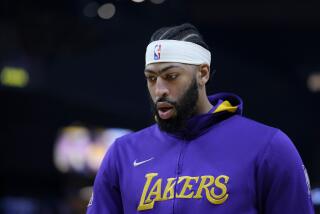Study: One Concussion May Lead to Another
WASHINGTON — High school and college football players who have one concussion have a higher risk of a repeat--and soon, a study finds.
Researchers think the players are being sent back into the game before they have time to recover.
“If a person had a concussion in a given season, nearly 15% of those folks had a second concussion in the same season,” said Kevin M. Guskiewicz of the University of North Carolina, Chapel Hill. “That’s kind of alarming.”
Guskiewicz and his colleagues looked over reports by 242 certified athletic trainers responsible for more than 17,500 players over three years, starting in 1995. All the trainers diagnosed concussion by using the same classification system. Findings were reported in the September-October issue of the American Journal of Sports Medicine.
About 5% of players each year were listed as having concussions. Headache was the most common symptom, reported by 86% of players. Sixty-seven percent reported dizziness, and 59% reported confusion. More severe symptoms also were reported, including amnesia and loss of consciousness, but they were much less common.
The study also looked at how long players were kept out of play and practice to give them time to recover. Thirty-one percent were allowed to return in the same game, and the average wait was only 13 minutes, the report said. The rest were held out for averages of four days for mild concussion or eight days for a more severe one.
The athletes are not being held out long enough, Guskiewicz said. Players whose symptoms quickly go away should be kept out of the game for 15-20 minutes, and players whose symptoms last longer should be out for at least a week, starting from when their symptoms end, he said.
Early returns to play and practice may be why players with one concussion have a higher risk of a second one, Guskiewicz said. Compared with uninjured players, athletes who had one concussion had three times the risk of getting a second.
“The brain needs time to heal, just like the ankle does,” Guskiewicz said. Concussion can cause tissue in the brain to swell, and the swelling has to go away, he said. And the body systems that give a person a sense of balance, such as the vestibular mechanism of the inner ear, must have time to recover, he said.
The findings look right, said Dr. Mark Lovell of the University of Pittsburgh’s Sports Medicine Concussion Program, who was not connected with the study. “They kind of resonate with what we have been doing,” he said.
But grading a concussion based on a player’s symptoms and a trainer’s judgment is at least as much an art as a science.
The UNC reports of concussions may include miscounts, Lovell said. “I can’t say definitely that there is a onefold, twofold, threefold or fourfold change in risk associated with each concussion,” he said.
“Probably we miss one-third to one-half of the cases that actually occur,” said Dr. John D. Sutton of Northeastern Ohio Universities College of Medicine in Canton.
Trainers and team physicians are probably the only people in medicine who have to examine their patients from 30 feet away, Sutton said. And players, realizing they could be forced out of the game if they report symptoms, may not tell, he said.
Just the same, even a single concussion can be more dangerous than players think, partly because it affects their ability to think. Mental problems linger even after physical symptoms go away, Lovell said. Students who ordinarily do well on tests may show foggy thinking for days afterward, he said.
“I had to write a letter to the teachers of one of the students who had a trig test and bombed it two days after a concussion,” Lovell said. “He’s a 4.0, an excellent student; he’s not a slacker.”
*
National Institute of Neurological Disorders and Stroke Traumatic Brain Injury Information Page:
https://www.ninds.nih.gov/health--and--medical/disorders/tbi--doc.htm
National Information Center for Children and Youth with Disabilities Traumatic Brain Injury Fact Sheet:
https://www.nichcy.org/pubs/factshe/fs18txt.htm
More to Read
Go beyond the scoreboard
Get the latest on L.A.'s teams in the daily Sports Report newsletter.
You may occasionally receive promotional content from the Los Angeles Times.










